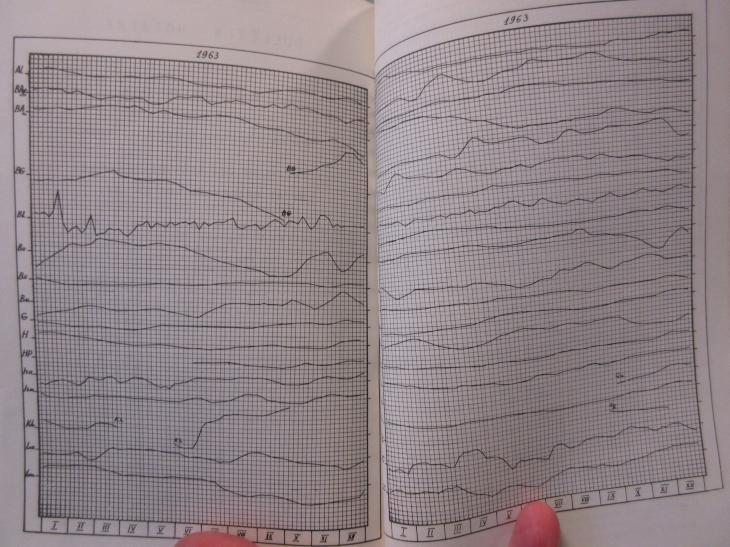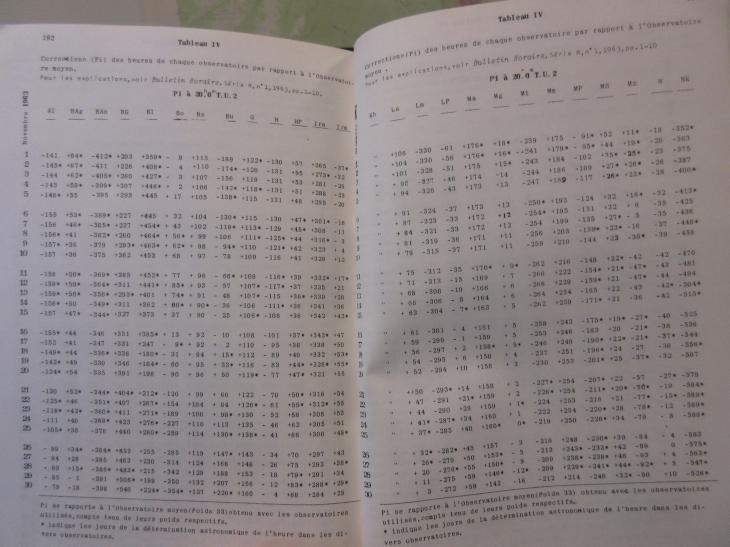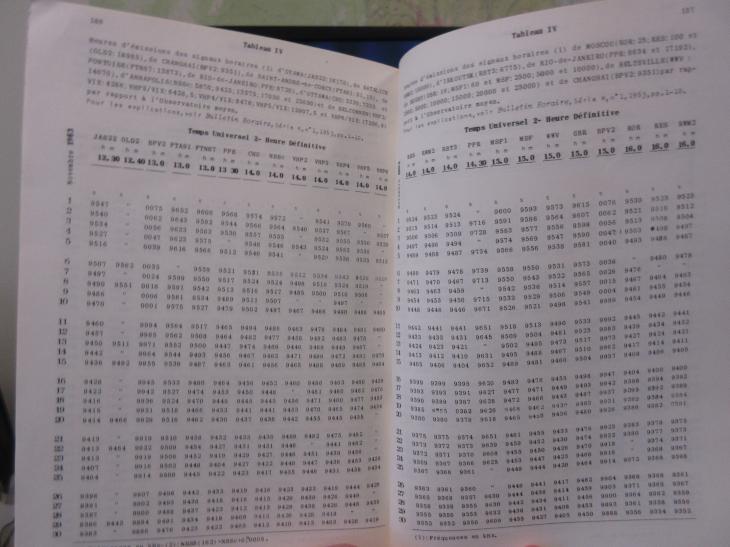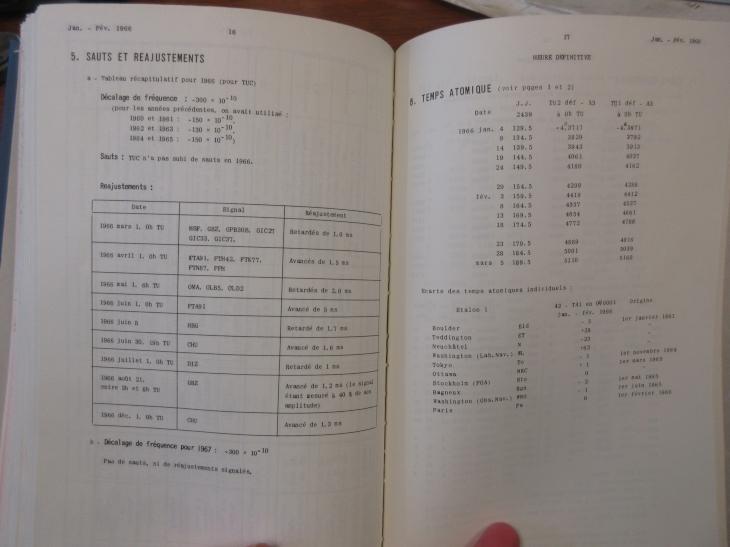Considerations for fractional second offsets in IANA tz zic
In 2018 February the IANA time zone mailing list began to discuss
fractional second offsets of time in the zic inputs.
The images on this page are snapshots of the history of the
accuracy of the available sources of time in the 1960s.
Sub-second accuracy of time raises questions which have not been
fully considered by the tz project.
The answers to those questions need context about the time scales
which were available in various jurisdictions.
Images
All images at 1/5 scale
All images at 1/2 scale
All images at full scale
 Image IMG_6701.JPG
1/2 scale
Image IMG_6701.JPG
1/2 scale
Bulletin Horaire, Series H, Number 6, pp. 174/175 (1963 Nov/Dec)
The plots show the differences between the time provided by various
observatories and the definitive UT2 time which each observatory
should have been providing if their time scale had been synchronized
with the worldwide average UT2.
In many cases these are national observatories charged with
providing the legal time for their jurisdiction.
Each vertical division is 0.01 s.
Note that the time provided by some observatories deviated from the
worldwide average by nearly 0.1 s over the course of the year.
 Image IMG_6703.JPG
1/2 scale
Image IMG_6703.JPG
1/2 scale
Bulletin Horaire, Series H, Number 6, pp. 192/193 (1963 Nov/Dec)
The tables give the differences between the time provided by various
observatories and the definitive UT2 time which each observatory
should have been providing if their time scale had been synchronized
with the worldwide average UT2.
These observatory time scales were often based on a conventional
longitude for an observatory which had been established decades
previously using a local geodetic datum which was very different from
a coordinate system that was self-consistent for the whole world.
In general the legal time scales maintained at the observatories were
not available in real time. They were available after the fact in
publications from those observatories as differences from some
radio broadcast time signals.
The BIH also tabulated the differences between various radio
broadcast time signals.
The inception of the International Time Bureau (BIH) in the early
1900s and these publications of the Bulletin Horaire had been
motivated by the observation that the radio broadcast time signals
provided by some observatories differed by as much as 1 or 2
seconds.
So for practical purposes of the time that people actually used
the observatory offsets are not relevant, but the radio broadcast
offsets are relevant.
 Image IMG_6702.JPG
1/2 scale
Image IMG_6702.JPG
1/2 scale
Bulletin Horaire, Series H, Number 6, pp. 186/187 (1963 Nov/Dec)
The tables give the differences between the time provided by various
radio broadcast time signals and the definitive UT2 time which each
broadcast should have been providing if their time scale had been
synchronized with the worldwide average UT2.
In many cases these are national time broadcasts charged with
providing the legal time for their jurisdiction.
For practical matters the radio broadcasts were available to
users of time, whereas the observatory time scales were not.
Therefore the radio broadcasts better describe the actual practice by
populations.
 Image IMG_6704.JPG
1/2 scale
Image IMG_6704.JPG
1/2 scale
Bulletin Horaire, Series J, Number 13, pp. 16/17 (1966 Jan/Feb)
These pages show the magnitudes of jumps in the time scales of many
radio broacast time signals.
Note that in the late 1960s there were still jumps greater
than 1 ms.
Questions that the IANA tz should consider
Note the jump of station CHU on 1966 June 30.
CHU is a national broadcast time signal providing legal time for
Canada.
On that date there was no adjustment of station WWV, which is a
national broadcast time signal providing legal time for the United
States.
For the case of sub-second offsets, does the tz project want
to split the America/<pickone> zones to indicate that the
US and Canada had different time offsets before and after
events like this?
Should tz prefer the intended time offsets from UT/UTC according to
legal decrees only (in the absence of technical details), or the
offsets from UT/UTC actually used by people who at best had access to
some radio broadcast time signals?
Where will the tz database make the distinction?
If tz chooses to ignore technical details, then most of the sub-second
offsets of local mean time are irrelevant because the contemporary
practice of time-keeping had systematic offsets and lack of accuracy
which do not justify keeping offsets to even 0.1 s of sub-second
precision.
Alternatively, if tz allows for nanosecond offsets, then it risks
wanting to include the monthly publications of BIPM Circular T where,
for example during 2017 December, the legal UTC time scale for
Hungary differed by about 70 ms from the worldwide average until late
in the month when it jumped to being off by only 5 ms. See
ftp://ftp2.bipm.org/pub/tai//Circular-T/cirthtm/cirt.360.html
Looking at this another way, 1 s of time corresponds to 1/4 nautical
mile at the equator, and less at higher latitudes.
Until the 1970s the best real-time navigation system was LORAN-C, which
had a worldwide accuracy of about 1/4 nautical mile.
Similarly, until the 1970s the offsets of longitude inherent between
various geodetic datums around the world tended to be 1/4 nautical
mile or more.
So despite what a current GPS-based map shows for the longitude of an
observatory providing the legal time for its surrounding region, the
conventional longitude of that observatory which had been used for
calculating values of time from that observatory was likely to be off
by 1 s of time from values produced by other observatories.
Steve Allen <sla@ucolick.org>
UCO/Lick Observatory
University of California
Santa Cruz, CA 95064
Phone: +1 831 459 3046
FAX: +1 831 459 2298